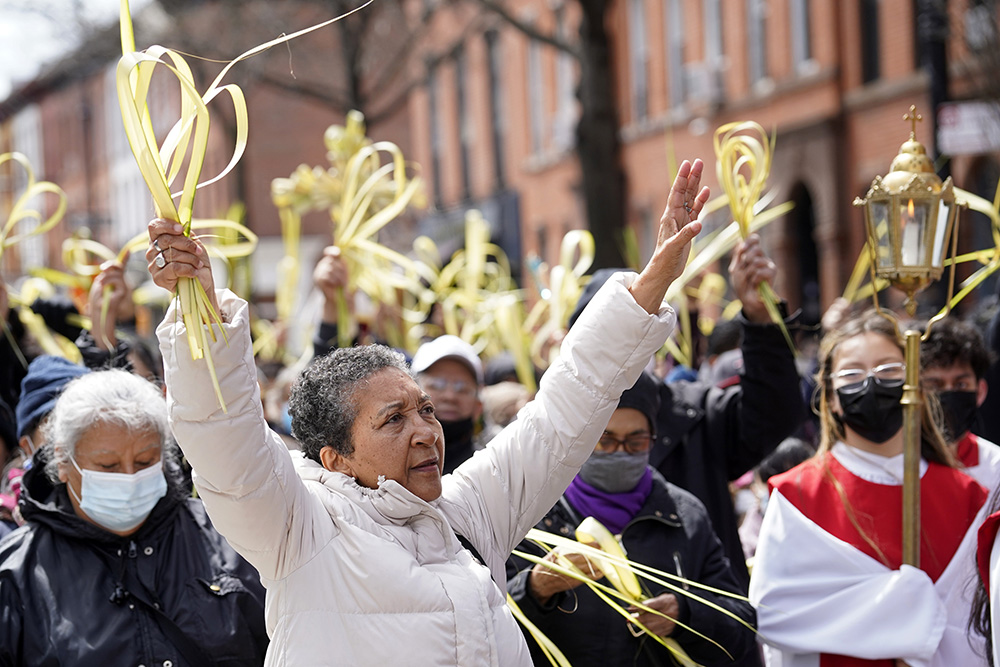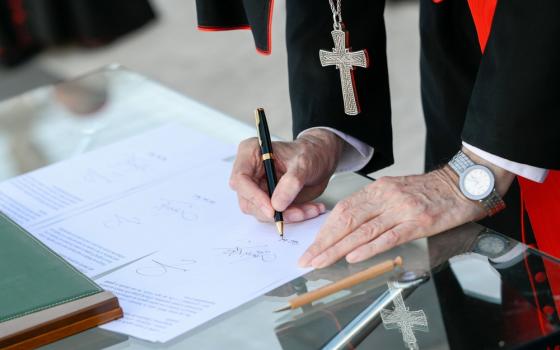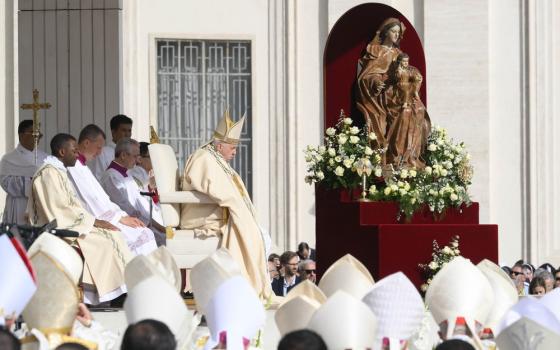
The faithful raise their palm fronds as they participate in a Palm Sunday procession April 10, 2022, in the Prospect Heights section of Brooklyn, New York. (CNS/Gregory A. Shemitz)
Palm Sunday is not a liturgy for the faint-hearted. We start with a Gospel reading and procession, followed by the full eucharistic celebration. Selections from Isaiah and Paul place Jesus' last hours in Jewish and Christian theological contexts and frame the solemn proclamation of the Passion according to Matthew.
Altogether, the Liturgy of the Word reminds us that Jesus' death was neither accidental nor blind fate but a destiny that he faced in conscious freedom.
We can safely assume that the early church and probably even Jesus himself interpreted the Passion through the lens of Isaiah's famous Servant Songs. Our first reading, the third of these, focuses on the servant's keen awareness of God's presence in the midst of suffering. The servant summarizes his entire approach to life with the line, "Morning after morning God opens my ear that I may hear; and I have not turned back."
Paul elaborates on Jesus' servant attitude in the hymn he quotes for the Philippians. According to Paul, Jesus made no pretense of being above suffering. As the model for humanity, he did not grasp for majesty, but exemplified acceptance (obedience) of his vocation to be the very image of God through self-giving.
No threat or pain, not even death, would sway him from being true to who he was. Jesus' obedience, an attitude that sprung from his relationship to God, impelled him to face freely the definitive conflict of his life.
Jesus' clearest expression of the decision to confront the powers aligned against him came with his entry into Jerusalem, every detail of which revealed who he was even as his actions fulfilled ancient prophecies. He could have processed in with the crowds like any other pilgrim. But no, fully aware of its prophetic symbolism, Jesus rode a common work animal into the city.
The rabbi who wove a parable about the scandal of not dressing properly for a wedding banquet reenacted the prophecy of Zechariah (9:9-10) in an extravagant, festive, yet humble illustration of his attractive power, a power that could defeat the oppression of status, weapons, horses and chariots. The route Jesus chose recalled Zechariah's prophecy that the day of the Lord begin with God's feet planted on the Mount of Olives (Zechariah 14); the people's decision to wave branches and pave the way with their cloaks signaled their recognition of him as God's chosen king (2 Kings 9).
Obedient to his discernment of God's will, Jesus entered Jerusalem as a messiah who would not meet any human expectations.
Beginning with that, we can listen to Matthew's Passion narrative attentive to learning how Jesus confronted evil.
Never falling into the role of a victim, Jesus remained the protagonist. At the supper, he used and modified the traditional blessings to indicate that he inaugurated the new covenant. In dialogue with those who would betray him, he offered compassion. Facing those who tortured and sentenced him, he refused to argue, knowing that his vision and power had no common ground with theirs.
At the end, using the words of a psalm, he shouted at God in utter desolation: "Why have you abandoned me?"
Advertisement
This cry of the heart is the ultimate prayer. Jesus, representing every human being who has striven to be faithful and feels a failure in every way, could do no more than lament before God. This was the last gasp of one who believed in God more than in his own expectations. Even while feeling deserted, he turned to the God he could never fully comprehend.
There is no greater act of faith than to pray in the midst of such desolation.
Matthew tells us that when Jesus cried his last lament, the veil of the temple was torn in two, from top to bottom. The veil that marked the separation of holy and profane was ripped apart, starting from heaven. In Jesus, a vulnerable, loving God had become visible and inseparable from creation.
Palm Sunday leaves us there, in death and desperation. Faithful disciples did the little they could by burying him and watching where he was laid. During the Triduum, we will again remember the events of Jesus' last days. We are invited to watch him, to learn from him what it means to have faith. We are encouraged to go to the depths with him, knowing that he goes with us.
The opening liturgy of Holy Week calls us to be stouthearted. It reminds us that the godliness to which we would naturally cling has nothing to do with the God of Jesus. This is the time to watch and pray and let Jesus lead us to new depths.








